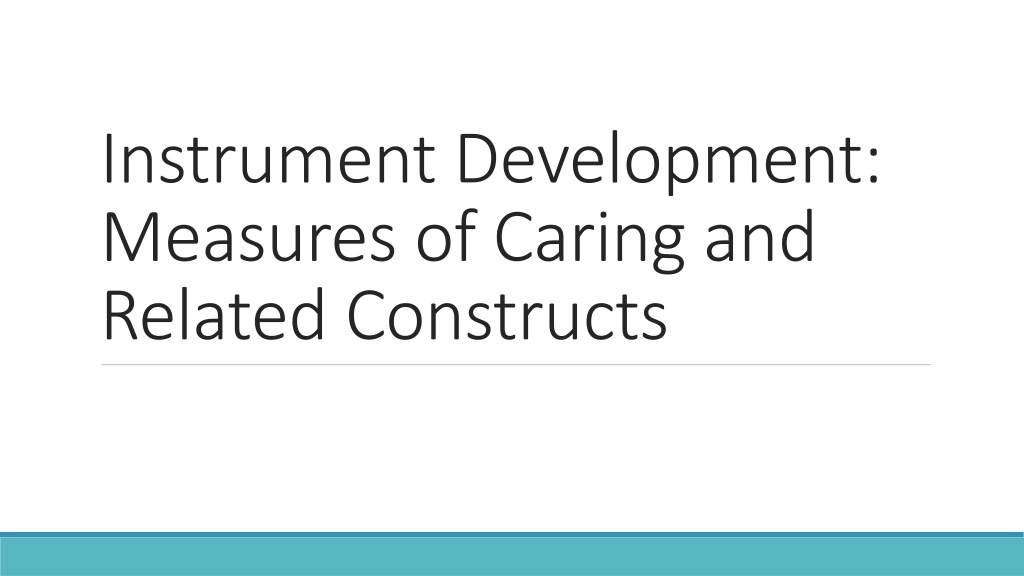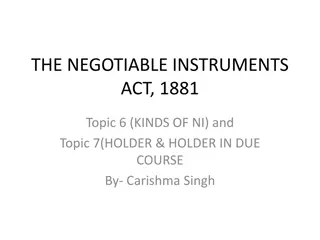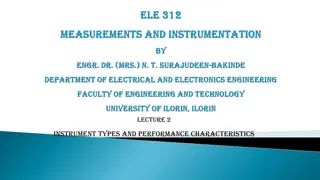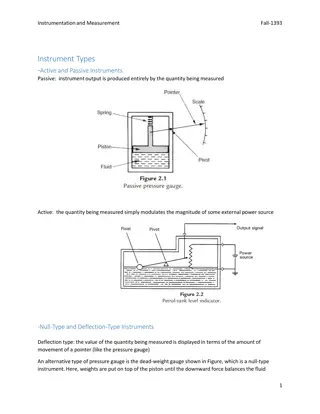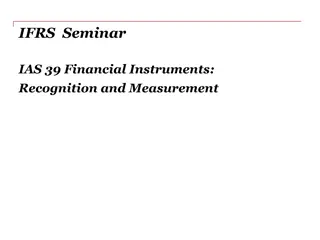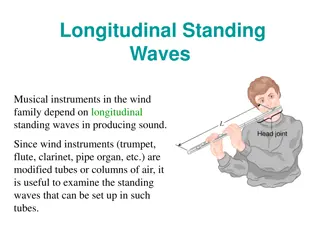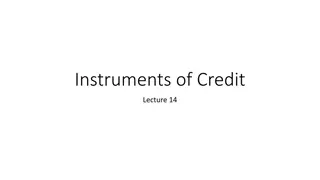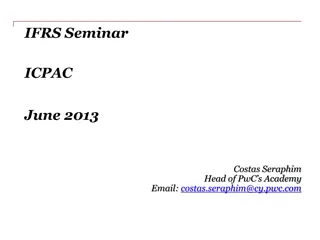Understanding Measurement and Instruments in Research
Exploring the significance of instruments in research, this content delves into the development and utilization of measures for concepts like caring. It covers the various devices used to measure constructs, the rules governing measurement assignment, direct versus indirect measurement methods, and the importance of aligning measurement instruments with real-world objects. The provided visuals enhance understanding of these fundamental research concepts.
- Research instruments
- Measurement rules
- Direct measurement
- Indirect measurement
- Construct development
Download Presentation

Please find below an Image/Link to download the presentation.
The content on the website is provided AS IS for your information and personal use only. It may not be sold, licensed, or shared on other websites without obtaining consent from the author. Download presentation by click this link. If you encounter any issues during the download, it is possible that the publisher has removed the file from their server.
E N D
Presentation Transcript
Instrument Development: Measures of Caring and Related Constructs
Devices for Measuring Constructs Device = test of knowledge, machine, psychometric (psychologic measurement) instrument Administration elicits a sample of behavior for many purposes Sample of behavior represented by numbers: ultimate reduction, also operationalization of constructs Measurement: assign numbers to individuals responses, chart data, biophysiologic data, etc.
Measurement: Defined Rules for assigning numbers to objects to represent quantities of attributes Assign numbers to objects according to rules Remember attributes of objects vary day to day, from situation to situation, or from one object to another Variability: numeric expression that signifies how much of an attribute is present in the object Quantification communicates that amount
Rules and Measurement Numbers must be assigned to attributes of objects according to rules Scores assigned systematically The conditions and criteria with which the numeric values are assigned are specified The measurement instrument must correspond with the real world of the object being measured instruments help researchers to measure concepts/constructs/attributes
Direct and Indirect Measures of Concept/Construct Direct Measures: straightforward measurement of concrete object Indirect Measures: indicators of concept used to represent abstract concept
Direct and Indirect Measures of Concept/Construct Direct: blood alcohol level; arterial blood gas; mean arterial pressure; digitalis level; GSR (galvanic skin response) as pain indicator Indirect: Abuse-a-stick alcohol level; pulse oximetry; auscultatory blood pressure; symptoms of digitalis toxicity; pain level on VAS; intelligence; caring; pain; coping; anxiety; social support; teasing frequency and teasing bother; spiritual/coping; perception of individualized nursing care More indirect: phenomenological description; ethnographic analytic description
Measurement and Data Collection: Intersect Measurement Data Collection
Measurement Error Difference between what exists in reality and what is measured (obtained or observed score) by a research instrument Measurement exists in direct and indirect measures Measurement errors include: Random error Systematic error
Variance: Errors of Measurement Systematic variance: leans in one direction; scores tend to be all positive, all negative, all high, or all low Error is constant or biased Glucometer and electronic thermometer that are not calibrated Postpartum depression instrument measures depression scores too high
Variance: Errors of Measurement Random error or error variance: variability of measures due to random fluctuations whose basic characteristic is that they (fluctuations) are self- compensatory Unpredictable Dialysis patients tested for cognitive functioning on first day of their dialysis schedule Participant affected by family stress
Factors Contributing to Errors of Measurement Situational contaminants (presence of researcher) Transitory personal factors (anxiety) Response-set biases (social desirability, extreme responses, acquiescence) Administration variations (change test/instrument instructions)
Factors Contributing to Errors of Measurement Instrument clarity (directions) Item sampling (which questions included on test) Instrument format (ordering of questions) Readability level, e.g., Flesch-Kincaid Grade Level
True score + Error score = Observed score Direct measures are more accurate than indirect measure True score = what would be obtained if there were no errors in measurement Systematic error = considered part of true score and reflects true measure Error score = amount of random error in measurement process
Test/Instrument Scaling Item scaling Nominal, Ordinal, Interval, Ratio Item weighting Directions specify item and factor (domain) weighting Total Score calculation Summing items; converting ordinal to interval level data
Item Formatting Types Multiple choice Dichotomous multiple choice Yes, No Bipolar scale Agree/disagree scale Preference ordering question Ranking ordering question Semantic differential scale Unipolar scale (one item) Absence or presence of single item, e.g., Not at all satisfied, slightly satisfied, moderately satisfied, very satisfied, and completely satisfied
Examples of Item Scaling Nominal Nurses spend time with the patient. (1 = Yes, 0 = No) Ordinal Accepts me as I am. (1 = Never, 2 = Rarely, 3 = Occasionally 4 = Frequently, 5 = Always) (Staff Nurse Survey, Duffy) Interval/Ratio Nurses point out positive things about me. (mark 10 cm line, VAS) NEVER TRUE FOR ME 0 ____________________ 100 ALWAYS TRUE FOR ME (Caring Behavior of Nurses Scale, Hinds)
Reliability and Validity Both needed for valid instrument Ongoing processes needed e.g. reliability needs to be established with each new sample
Reliability: Quality Measure of Instrument Dependability, stability, consistency, predictability, comparability, accuracy Indicates extent of random error in measurement method Test is reliable if observed scores are highly correlated with its true scores How consistently measurement technique measures concept/construct (same trait) (internal consistency) If two data collectors observe same event and record observations on instrument, recording comparable (interrater) Same questionnaire administered to same individuals at two different times, individuals responses remain same (test-retest)
Reliability Instruments that are reliable provide values with only small amount of random error Reliable instruments enhance the power of the study 1.00 is perfect reliability; 0.00 is no reliability
Types of Reliability test-retest (two administrations of same test) comparison of means t-test: t value or t statistic OR correlate results Pearson Product Moment Correlation or r Time1: administer the CBI to a group of nurses Time 2: administer the CBI to the same group of nurses
Types of Reliability Equivalence Interrater or interobserver percentage of agreement: number of agreements/number of possible agreements = interrater reliability Cohen s kappa Phi (nominal, dichotomous) correlation (Pearson r; Kendall s tau) intraclass correlation coefficient (ANOVA) Alternate or parallel forms (two parallel tests) correlation
Types of Reliability Homogeneity Internal consistency Cronbach s alpha (ordinal items) Modest sample size: at least 25 Kuder-Richardson 20 (dichotomous items)
Reliability Ischemic Heart Disease Index: coding reliability reported by the authors was .71. Adult-Adolescent Parenting Inventory (AAPI): Regarding Inappropriate Expectations subscale: in previous studies, Cronbach s alphas ranged from .40 to .86. Reliabilities in current study ranged from .40 to .84. This subscale was dropped from further analyses. Cronbach s alphas are never obtained at a score of 1.00 because all instruments have some measurement error Test-retest reliability coefficients were r = 0.92 for the whole instrument (SIP) and averaged r = 0.82 for the 12 categories of dysfunctional behavior when two tests were administered at 24-hour intervals Arterial oxygen saturation was measured by a Nellcor pulse oximeter (Nellcor Inc., Hayward, CA), placed on the subject s index finger (obtain manufacturer s product information; conduct test/retest calculations yourself)
Reliability Anxiety subscale i1 i7 i14 i23 i37 reliability coefficient N = cases = 125 N of items = 5 alpha = 0.3682
Validity: Defined Extent to which instrument actually reflects abstract construct being examined; measures what it is supposed to measure Domain or Universe of Construct Concept analysis Extensive literature search Qualitative study results Theoretically define the construct and subconcepts Blueprint or matrix Test items Instrument items
Validity Types Face Validity Instrument looks like it is measuring the construct
Validity Types Content validity: extent to which method of measurement includes appropriate sample of items for construct being measured and adequately covers construct; based on subjective judgment evidence comes from literature representatives of relevant populations content experts
Validity Types Content Validity: Expert validity experts (5 or more) judge the items in relation to fit with construct and subscales of construct experts rank items on scale experts characteristics are described experts use scale 1 = not relevant; 2 = unable to assess relevance without item revision or item in need of such revision that it would no longer be relevant; 3 = relevant but needs minor alteration; 4 = very relevant and succinct means calculated and decisions made about items (Lynn, 1986; Thomas, 1992) comments included offering critique of items, etc. including readability and language used
Content-Related Validity: Expert Content Validity Index (CVI) Numerical value reflecting level of content-related validity Experts rate content relevance of each item using 4-point rating scale Items rated according to 4-point Lynn scale Complete agreement among expert reviewers to retain an item with 7 or fewer reviewers Relevance = 4 on 4 pt. scale 4 of 6 reviewers rate each item relevant; 4/6 or 0.67% The Observable Displays of Affect Scale (ODAS): Ten gerontological nursing experts established content validity (Vogelpohl & Beck, 1997).
Instrument Readability there are over 30 readability formulas index of probable degree of difficulty of comprehending text Fog formula example of readability formula Flesch-Kinkaid Grade Level Word: calculates readability level
Content-Related Validity: Example CBI-E items originated in related literature and research on nurse caring from patients and nurses perspectives as well as expert review. Six experts in gerontologic nursing reviewed the CBI-E and rated the items, directions, length, and other critical points regarding this draft so that content validity of the expert type (Burns & Grove, 2005) was established. Three of the experts were doctoral-prepared. Two were geriatric nurse practitioners, three were clinical nurse specialists, one was a long-term care administrator, and one was a psychiatric-mental health clinician. The content validity (content relevance) of each item was rated by experts using the following 4-point rating scale (Lynn, 1986): 1 = not relevant; 2 = unable to assess relevance without item revision or item is in need of such revision that it would no longer be relevant; 3 = relevant but needs minor alteration; 4 = very relevant and succinct (p. 384). Items were revised based on expert reviews and one item was eliminated from the 29-item draft. This item had the lowest mean. Experts commented on nebulous wording on specific items and on the excellence of many. Specific item revisions were offered and the investigators modified several items accordingly.
Types of Content Validity Content Validity: Theoretical validity the domain of the construct is identified through concept analysis or extensive literature search; qualitative methods can also be used a matrix or blueprint is created to develop items for a test item format, item content, and procedures for generating items carefully described
Construct Validity: Factor Analysis Validity Relationships among various items of instrument established; items fall into a factor, correlate with other items Items that are closely related are clustered into a factor factor = subscale = dimension Instrument may reflect several constructs rather than one construct factor loadings (-1 to +1) may be thought of as correlations of the item with the factor
Construct Validity: Factor Analysis Validity Number of constructs in instrument can be validated through use of confirmatory factor analysis Factor loadings are proportion of variance the item and factor have together Communality is portion of item variance accounted for by various factors Eigenvalue for factor is total amount of variance explained by factor (add squared loadings contained in single column [factor]) Factor eigenvalues and variance accounted for are most important results in unrotated factor matrix
Construct Validity: Examples Construct validity of the State and Trait Anger Scales (20 items) (was assessed by Spielberger et al. (1983) using principal factor analysis with orthogonal rotation, which determined the state- trait anger scales. Fuqua et al. (1991) reported a similar factor structure in 455 college students.
Types of Construct Validity Construct Validity: test assumptions about instrument; extent to which test measures theoretical construct Hypotheses identified about expected response of known groups Contrasted or known groups: groups who have significantly varied scores on instrument Alcoholics versus teetotalers on Alcoholism Health Risk Appraisal Instrument t-test or ANOVA determines difference
Types of Construct Validity Construct Validity: Hypothesis-testing approach Theory or concept underlying instrument s design used to develop hypotheses regarding behavior of individuals with varying scores on the measure; determine if rationale underlying instrument s construction is adequate to explain findings
Types of Validity Construct Validity: Divergent validity Instrument that measures the opposite of construct is administered to subjects at same time the instrument measuring variable in research question is; results are compared with correlation coefficient (r = - 0.??) Hearth Hope Scale and Hopelessness Scale Fear Survey Scale and Happiness Scale
Types of Validity Construct Validity: Convergent validity Two or more tools that measure the same construct are administered at same time to same subjects; demonstrated by high correlations between scores (r = + 0.??) Personal Resource Questionnaire and Norbeck Social Support Questionnaire Anxiety Scale and Nausea Distress Scale
Construct Validity: Example Validity of the anxiety VAS has been established using such techniques as concurrent validity and discriminate validity. The VAS has been described as an accurate and sensitive method for self- reporting preoperative anxiety. Anxiety scores on the visual analogue scale (VAS) have been highly correlated (r = .84) with State-Trait Anxiety Inventory scores.
